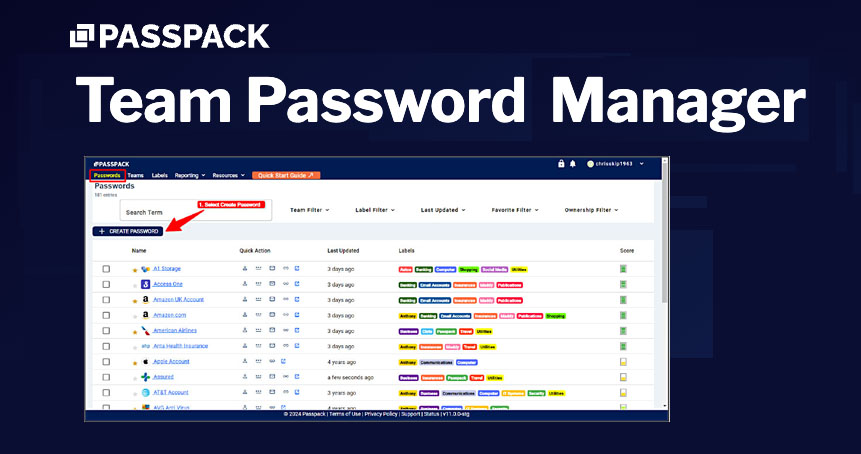The Secret Weapon for Team Security: Shared Credential Managers
Picture this: It’s Monday morning. You’re gearing up for a productive week, coffee in hand, when suddenly – bam! – you’re hit with the dreaded “What’s the password?” message. Again. Sound familiar? If you’re nodding along, you’re not alone. In fact, you’re about to discover a solution that’s so game-changing, you’ll wonder how you ever managed without it.

Welcome to the world of shared team credential managers – the unsung heroes of the digital workplace. As someone who’s been in the trenches of password chaos and emerged victorious thanks to PassPack, I’m here to spill the beans on the tool that’s revolutionizing how teams handle their digital keys. Buckle up, because we’re about to embark on a journey that’ll transform your team’s security, boost productivity, and banish those password headaches for good.
Ready to dive in? Let’s start with the essentials:
Key Takeaways:
- Shared team credential managers are essential for modern business security
- They offer centralized control, easy sharing, and enhanced protection
- Choosing the right solution can significantly boost team productivity
In today’s digital landscape, managing passwords and credentials for a team can feel like herding cats. As someone who’s been using PassPack for the past three months, I’ve discovered the game-changing power of a shared team credential manager. If you’re drowning in a sea of sticky notes or constantly fielding “What’s the password again?” messages, this article is for you.
The Password Predicament: Why Your Team Needs a Better Solution
Let’s face it: passwords are a pain. We need them for everything, from accessing project management tools to logging into client accounts. But when you’re working in a team, the challenge multiplies. How do you share passwords securely? How do you revoke access when someone leaves? How do you ensure everyone’s using strong, unique passwords for each account?
Enter the shared team credential manager – the unsung hero of modern business security.
What Exactly is a Shared Team Credential Manager?
At its core, a shared team credential manager is a secure digital vault for all your team’s login information. But it’s so much more than that. Think of it as your personal security guard, password generator, and team coordinator all rolled into one.
Here’s what a good shared team credential manager should offer:
- Centralized storage: All passwords in one secure location
- Easy sharing: Grant and revoke access with a few clicks
- Strong encryption: Your data is locked down tight
- Password generation: Say goodbye to “password123”
- Access control: Decide who sees what
- Audit trails: Know who accessed what and when
The Benefits That Will Make You Wonder How You Ever Managed Without One
After using PassPack for three months, I can confidently say that a shared team credential manager is a game-changer.

Let me explain why:
1. Time Savings That Add Up
No more digging through emails or messaging colleagues for passwords. Everything’s right there at your fingertips. In my experience, this alone saves each team member at least 15 minutes a day. That’s over an hour a week!
2. Security That Lets You Sleep at Night
With features like two-factor authentication and end-to-end encryption, you can rest easy knowing your sensitive data is protected. Plus, with auto-generated strong passwords, you’re far less vulnerable to breaches.
3. Onboarding and Offboarding Made Simple
Adding a new team member? Give them access to exactly what they need in minutes. Someone leaving? Revoke their access instantly. No more changing shared passwords every time there’s a staff change.
4. Collaboration Without the Chaos
Need to share client login details with a colleague? No problem. You can securely share credentials without ever revealing the actual password. It’s like magic, but it’s just good security.
The Features That Matter: What to Look For
Not all shared team credential managers are created equal. Here are the must-have features to look for:
| Feature | Why It Matters |
|---|---|
| End-to-end encryption | Ensures your data is secure, even from the service provider |
| Two-factor authentication | Adds an extra layer of security to prevent unauthorized access |
| Role-based access control | Allows you to set permissions based on team roles |
| Password strength analysis | Helps identify and replace weak passwords |
| Secure password sharing | Share access without revealing the actual password |
| Audit logs | Track who accessed what and when for accountability |
The Learning Curve: Getting Your Team On Board
Implementing a new system can be challenging, but the payoff is worth it. Here’s how to make the transition smooth:
- Start with a pilot group: Choose a small team to test the waters.
- Provide training: Offer a quick tutorial on how to use the new system.
- Lead by example: Use it consistently yourself and showcase its benefits.
- Gather feedback: Ask your team what’s working and what isn’t.
- Iterate and improve: Adjust your processes based on team input.
The ROI: Why It’s Worth the Investment
You might be thinking, “This sounds great, but is it worth the cost?” After using PassPack for three months, I can confidently say: absolutely.
Consider this:
- Productivity gains: Less time wasted on password management means more time for actual work.
- Reduced security risks: The cost of a data breach far outweighs the cost of prevention.
- Improved compliance: Many industries require secure password management – stay ahead of regulations.
In my experience, the return on investment becomes clear within weeks, not months or years.
The Human Factor: Why Your Team Will Thank You
Beyond the technical benefits, there’s a human element to consider. Implementing a shared team credential manager shows your team that you value their time and take security seriously. It eliminates the stress of managing multiple passwords and the fear of forgetting crucial login details.

In our team, it’s led to:
- Fewer frustrated sighs when accessing accounts
- More confident handling of client information
- A general sense of relief that password management is “taken care of”
The Next Steps: How to Get Started
Ready to dive in? Here’s your action plan:
- Research options: Look into solutions like PassPack, LastPass, or 1Password.
- Consider your needs: Team size, budget, and specific features required.
- Try before you buy: Most services offer free trials. Take advantage!
- Plan your rollout: Decide on your implementation strategy.
- Commit to the change: Success comes with consistent use.
Remember, the perfect solution is the one your team will actually use. Choose wisely, but don’t let perfect be the enemy of good.
The Future is Secure: Embracing Modern Password Management
In a world where data breaches make headlines daily, taking control of your team’s password security isn’t just smart – it’s essential. A shared team credential manager is more than a convenience; it’s a crucial tool for modern business security.
After three months with PassPack, I can’t imagine going back to our old ways. The peace of mind, efficiency gains, and improved security are invaluable. Whether you choose PassPack or another solution, taking this step will transform how your team handles sensitive information.
Don’t wait for a security incident to be your wake-up call. Embrace the power of shared team credential management today. Your future self (and your team) will thank you.
On a similar note, read Best Recruiting Software for Small Businesses.
FAQ
Q: How much time can a shared team credential manager really save?
A: In my experience, it saves each team member about 15 minutes per day, which adds up to over an hour a week. For a team of 10, that’s more than 40 hours a month!
Q: Is it really secure to keep all passwords in one place?
A: Yes, when done correctly. Quality shared team credential managers use robust encryption and security measures that are far more secure than storing passwords in emails or spreadsheets.
Q: What if the credential manager company gets hacked?
A: Reputable services use end-to-end encryption, meaning your data is encrypted before it leaves your device. Even if the company were hacked, your passwords would remain secure.
Q: How difficult is it to switch from our current system?
A: There’s a learning curve, but most teams adjust quickly. The key is good planning and communication. Many services offer tools to import existing passwords, making the transition easier.
Q: Can we still use personal password managers alongside a team solution?
A: Absolutely! Many people use a team solution for work-related passwords and a personal manager for their private accounts.